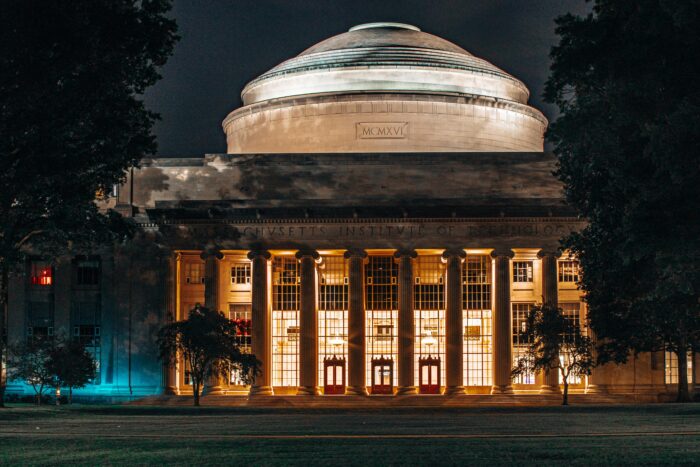I. Introduction
A. About MIT
Founded in 1861, the Massachusetts Institute of Technology (MIT) stands as a beacon of intellectual excellence and cutting-edge innovation. Recognized globally for its unparalleled contributions to science and technology, MIT consistently ranks among the top universities worldwide. With a host of illustrious alumni including 97 Nobel laureates, MIT is a crucible for pioneering ideas and groundbreaking discoveries. Situated in the vibrant technology hub of Cambridge, Massachusetts, this institution fosters an academic environment built on creativity, inclusivity, and global engagement. Whether it’s sending satellites into space or engineering the technologies of tomorrow, the intellectual rigor at MIT catalyzes student potential into transformative advancements.
B. The Competitive Nature of Admissions
MIT’s admissions landscape is a testament to its reputation. With a razor-thin acceptance rate of 4.5%, the competition is undeniably fierce. Each year, thousands of eager applicants throw their hats into the ring, yet only a select few achieve admission into this esteemed institution. To put this into perspective, in a recent cycle, MIT received approximately 20,000 applications, yet the incoming class numbered only around 1,450 students. This competition underscores the importance of crafting an application that doesn’t merely meet criteria but stands out with distinctive flair and earnestness. Prospective students are thus challenged to showcase not just stellar academic prowess, but also a depth of passion and ambition that aligns with MIT’s spirited quest for progress and invention.
Through a seamless fusion of these foundational insights, applicants gain a robust understanding of MIT’s rich heritage and its stringent admissions standards. Such a narrative prepares aspiring MIT students for the exciting journey of crafting their applications, infused with both precision and personality.
II. Understanding MIT’s Admissions Philosophy
A. Holistic Review Process
At MIT, the admissions philosophy is as much an art as it is a science. The institute invests in a holistic review process that extends beyond mere numbers and academic metrics. This comprehensive assessment recognizes that potential can’t be distilled into a GPA or test score alone. MIT’s admissions team meticulously considers a mélange of student characteristics including but not limited to creativity, drive, initiative, and the individual’s ability to thrive in collaboration. This is a strategic alignment with MIT’s mission to cultivate a diverse student body enriched with varied perspectives and unique talents, ultimately promoting innovation and an inclusive community. Harnessing this philosophy, MIT seeks individuals who are not only bright but also bring a rich tapestry of experiences and insights to campus.
B. What MIT Values in Applicants
Beyond academic aptitude, MIT values students who embody a true passion for learning and a zest for intellectual curiosity. Prospects who demonstrate leadership, whether tackled in traditional roles or through innovative and less conventional paths, resonate with MIT’s grounding principles. The admissions team is on the lookout for applicants who can seamlessly integrate into MIT’s rigorous, fast-paced learning environment while contributing their distinctive voices and perspectives to the academic debate. Moreover, what distinguishes successful candidates from the rest is their documented propensity for problem-solving, their inclination to make a substantial impact, and an undeniable enthusiasm for measured risk-taking—a hallmark of the entrepreneurial spirit that MIT celebrates. By seeking such multi-dimensional individuals, MIT ensures that its next generation of thought leaders will thrive and grow, contributing meaningfully to both the institute and the broader world.
III. Academic Excellence
A. Grade Point Average (GPA)
While MIT does not set a minimum GPA requirement, outstanding academic performance is a clear expectation for all applicants. Prospective students are typically among the highest achievers, often boasting GPAs of 3.5 and above. This emphasis illustrates MIT’s commitment to admitting students who have mastered core academic competencies and who consistently perform at an exceptional level. Aspiring students should view their GPA not just as a number, but as an indicator of their dedication and perseverance in navigating advanced intellectual challenges.
B. Class Rank
MIT places a strong emphasis on being at the pinnacle of academic performance within an applicant’s school. Impressively, 97% of the students admitted to MIT were in the top 10% of their high school graduating classes. This metric underscores the caliber of students typically forwarded by successful applicants, reflecting rigorous commitment and a competitive edge in scholarly pursuits.
C. Course Rigor
Success at MIT is imbued with a robust foundation in demanding coursework, particularly in areas that directly feed into its STEM-centric focus. MIT looks favorably upon applicants who have challenged themselves with rigorous courses, ensuring they are well-prepared for the institution’s demanding curriculum. Courses in calculus, physics, chemistry, and biology, alongside rigorous humanities and social sciences classes, form the bedrock of a strong applicant profile. Such choices indicate an applicant’s readiness and ability to manage the formidable academic challenges that MIT provides.
D. SAT/ACT Requirements
The standardized testing policy at MIT reinforces its commitment to attracting top-notch talent. The average SAT scores for enrolled students typically hover around 1500-1570, while ACT scores range between 34-36. MIT also practices superscoring, allowing applicants to showcase their best combined scores across multiple test sittings. This thoughtful approach highlights MIT’s dedication to evaluating students at their best, reflecting their true potential rather than a single test day’s performance. Together, these metrics help paint a comprehensive picture of an applicant’s academic readiness for MIT’s challenging academic environment.
IV. Extracurricular Activities & Demonstrated Interest
A. Quality Over Quantity
In the realm of extracurriculars, MIT prioritizes depth and significance over a laundry list of activities. Applicants are encouraged to engage deeply in a few passions, leaving a mark and demonstrating consistent involvement. This quality-over-quantity approach underscores MIT’s interest in students who dedicate themselves to pursuits they truly care about, rather than those amassing activities for appearances. Exceptional extracurriculars reveal a candidate’s ability to balance academia with personal interests, showcasing their capacity to contribute uniquely to campus life.
B. Leadership and Impact
MIT is on the lookout for evidence of leadership and impact in applicants’ extracurricular endeavors. Whether it’s spearheading a community initiative, leading a robotics team, or organizing a charity event, the ability to lead and inspire others is a trait highly valued. Successful applicants highlight these narratives, showing how their leadership has led to tangible improvements or widespread participation. For MIT, leadership is not about titles but about genuine influence and positive change within teams or communities.
C. Passion Projects and Unique Interests
Passion projects present a golden opportunity for applicants to highlight their unique interests, serving as a window into who they are and what drives them. These personalized ventures could range from a self-directed research study to an entrepreneurial endeavor, or even the creation of an art portfolio. MIT values these projects because they demonstrate initiative, originality, and perseverance—traits that align well with its culture of innovation.
D. Campus Visits and Virtual Tours
Both in-person campus visits and virtual tours present excellent opportunities for applicants to demonstrate genuine interest in MIT. Participating in these offerings indicates an investment in understanding MIT’s unique environment. While campus visits allow students to experience MIT’s atmosphere firsthand, virtual tours provide a convenient alternative that conveys the same interest and commitment.
E. Engaging with Admissions
Interacting with the admissions office, whether through webinars, informational sessions, or college fairs, further illustrates a candidate’s sincere interest. These interactions provide prospective students avenues to deepen their understanding of MIT and display their intent to join its community. Engaging thoughtfully with admissions also helps candidates craft more tailored and informed applications, resonating with both authenticity and excitement for the prospect of studying at MIT.
V. Personal Essays and Statements
A. MIT-Specific Essay Prompts
MIT’s application process includes its own set of essay prompts designed to elicit genuine and thoughtful reflections from applicants. These prompts encourage students to delve deeper than surface-level information, sharing insights into their problem-solving capabilities, their alignment with MIT’s mission, and aspects of their personal journeys that have shaped their perspectives. The essence of these essays lies in their ability to reveal the applicant’s originality and the narrative that collectively encapsulates their life experiences.
B. Writing an Authentic Personal Statement
Crafting a compelling personal statement requires authenticity and clarity, letting the applicant’s genuine voice and personality shine through. Applicants should weave a cohesive narrative that not only aligns with the prompts but also resonates with sincerity. It’s a space to articulate experiences, values, and lessons learned, relaying how these factors have influenced their decision to apply to MIT. Emphasizing moments that truly matter to the applicant provides a window into their character and how they might contribute to the MIT community.
C. Common Pitfalls to Avoid
Writing essays that stand out involves navigating potential pitfalls. Applicants should avoid overused themes, clichéd notions, or broad generalizations, each of which can dilute the distinctiveness of the applicant’s voice. It is crucial to eschew insincerity, as admissions officers can readily detect when essays lack authenticity or are tailored to what applicants assume reviewers want to hear. Attention to detail, particularly regarding grammar and syntax, is essential to convey professionalism and care. The essays should reflect a polished, thoughtful approach, underscoring the applicant’s readiness to embrace the creative challenges an MIT education entails.
VI. Letters of Recommendation
A. Selecting the Right Recommenders
Choosing the right recommenders is pivotal to bolstering an application’s narrative. MIT looks for recommendations that can vividly showcase an applicant’s academic capabilities and character from different facets. To provide comprehensive insights, applicants are advised to select teachers spanning both science/math and the humanities/social sciences. This balance ensures that recommendations capture the student’s multifaceted brilliance and ability to engage across disciplines, reflecting MIT’s interdisciplinary ethos.
B. Providing Guidance to Recommenders
Providing clear guidance to recommenders is critical in ensuring letters accurately portray the applicant’s strengths and achievements. Applicants should furnish teachers with comprehensive materials such as their resume, specific courses they excelled in, extracurricular endeavors, and any key achievements or passions relevant to MIT’s ethos. These insights enable recommenders to craft letters that are not only detailed but resonate with the particular dynamics of MIT’s challenging academic environment. This thoughtful preparation facilitates letters that do more than confirm academic prowess—they illuminate the applicant’s potential to excel at MIT.
VII. The Interview Process
A. Interview Availability
MIT offers interviews through its extensive network of alumni volunteer interviewers. Interviews are typically arranged based on availability in the applicant’s local area or, in some cases, conducted virtually for international applicants. These interviews are valuable touchpoints, providing a personal dimension to the application while offering insights beyond what is present on paper. They also serve as an excellent forum for applicants to learn more about MIT from someone who has firsthand experience.
B. Preparing for the Interview
Preparation is key to making a strong impression during the interview. Prospective students should anticipate a blend of questions varying from academic interests to personal achievements and future aspirations. It’s beneficial to reflect beforehand on why MIT is a critical next step in their academic journey and how their past pursuits align with MIT’s culture of innovation and problem-solving. Engaging with relevant MIT faculty or attending webinars can furnish them with additional context to discuss how the institution’s resources would be utilized in their educational path.
C. Making a Positive Impression
Beyond content, the demeanor of the applicant during the interview contributes significantly to lasting impressions. Enthusiasm, honesty, and an inquisitive nature combined with rigorous preparation can truly distinguish an applicant. As important is following up with a thank you note, highlighting specific points from the interaction that reinforced their interest in MIT. This small gesture underscores a candidate’s professionalism and reinforces their eager commitment to becoming a part of the MIT community. Through these measures, applicants demonstrate their readiness not just to attend MIT, but to contribute actively to its vibrant dynamic.
VIII. Financial Considerations
A. Understanding Tuition Costs
Navigating the expenses of a top-tier education, understanding Mith’s financial requirements provides crucial clarity for applicants and their families. The comprehensive breakdown for MIT includes tuition, fees, and additional expenditures such as room and board. However, it’s important to appreciate these figures within the context of MIT’s commitment to alleviating financial pressure for those in need.
B. Financial Aid Opportunities
MIT shines in its approach to financial assistance, embodying a need-blind admission process that affirms its dedication to welcoming talented students irrespective of their financial backdrop. Moreover, MIT pledges to meet 100% of demonstrated financial need for all admitted students—a promise that has empowered many students from diverse backgrounds to embark on an MIT education without the heavy burden of financial anxiety.
C. Applying for Financial Aid
Applying for financial aid at MIT involves completing forms such as the Free Application for Federal Student Aid (FAFSA) and the CSS Profile. This paperwork is pivotal in assessing financial need and must be submitted within specified deadlines to ensure full consideration. With meticulous planning and timely submissions, applicants can effectively tap into the support systems MIT has established, enabling students to focus on their educational journey with financial relief in place. By understanding and leveraging these financial possibilities, students are well-positioned to take advantage of the educational opportunities MIT has to offer without monetary constraints impeding their academic progress.
IX. Special Applicant Categories
A. International Applicants
For international applicants, navigating the MIT admission process involves keen attention to additional requirements and competencies. Crucially, non-native English speakers must demonstrate English proficiency, typically through standardized tests such as the TOEFL or IELTS. This requirement ensures that international students are equipped to fully engage with the demanding academic environment at MIT. Additionally, understanding variations in academic settings, grading systems, and educational documentation from around the world, MIT’s admissions team evaluates international transcripts carefully to align with its own rigorous standards.
B. Transfer Students
Transfer applicants to MIT undergo a distinct evaluation process that seeks indications of comparable academic accomplishments and progress towards a degree. Typically, transfer applicants have already completed significant college coursework that aligns with MIT’s rigorous expectations. The process necessitates a detailed presentation of previous college experiences, activities, academic efforts, and a robust case for why MIT is the ideal fit for their continued studies. Engage fully with MIT’s detailed academic prerequisites and preferred course histories for prospective transfer students to adequately prepare for this opportunity.
C. Underrepresented Groups
MIT fervently embraces a diverse and inclusive community atmosphere, providing support and resources for underrepresented and minority groups. The institution engages in various initiatives to ensure that first-generation students, minorities, and other underrepresented applicants have the resources and communal support they need to succeed academically and socially. Programs such as the MIT Summer Research Program introduce underprivileged students to the supportive environment awaiting them, facilitating their transition into MIT’s spirited academic setting. Programs like these aid MIT in maintaining a rich, diverse campus culture that fosters creativity and synergistic collaboration among a myriad of students.
X. Final Tips for Success
A. Starting Early
One of the linchpins of a successful MIT application is starting the process early. Crafting an application reflective of one’s true potential takes time, allowing for detailed introspection, essay refinement, and strategic planning. Early involvement enables applicants to manage their schedules better, meet all the necessary application components with precision, and avoid the stress of last-minute submissions, thus ensuring every aspect of their submission is polished to perfection.
B. Seeking Guidance
Aspiring MIT students are encouraged to actively seek guidance throughout their application journey. Engaging with teachers, school counselors, mentors, and even peers provides invaluable perspectives and feedback that can fine-tune an application. Moreover, reaching out to current MIT students or alumni can offer aspirants firsthand insights into navigating the MIT experience and preparation for the holistic admissions process.
C. Staying Authentic
Authenticity reigns supreme in crafting an MIT application. Every element, from essays to interviews, should genuinely reflect the student’s personal experiences, aspirations, and attributes. MIT’s admission officers are adept at identifying applicants whose stories resonate with sincerity and meaning, thus underscoring the importance of applicants being true to themselves rather than what they presume reviewers desire.
D. Professional Help
For those who need additional insight or wish for strategic guidance, professional consulting services like MBA Exchange can prove to be quite beneficial. These services personalize coaching and advice tailored to the MIT application process, offering professional critiques and strategic development based on extensive expertise. Such resources can further enhance an applicant’s ability to present their education trajectory compellingly and effectively. Through a combination of self-driven effort, focused guidance, and authenticity, applicants can enhance their prospects of becoming a part of the world-renowned MIT community.





